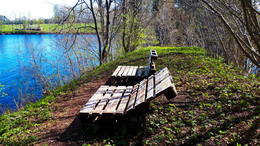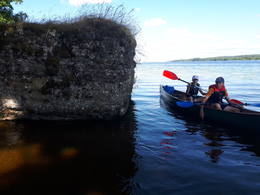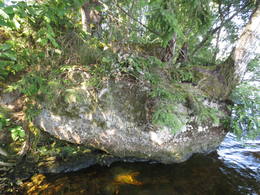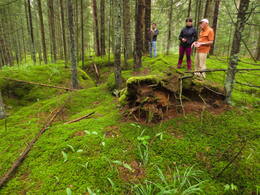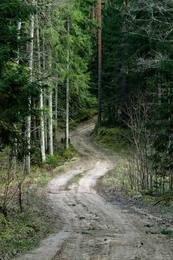Rescue the Nega River Bridge from blasting
By the time the Germans retreated in 1944, many important sites had been blown up and it was very difficult to prevent, but there are also stories of miraculous events where the courage of the locals and the tolerance of a soldier allow salmon to survive in places important to the locals. One of the stories is also about a discussion between a housewife and a German soldier who saved an entire bridge from being blown up.
The story is about the Nega River Bridge.
When the Germans retreated along our house in the direction of Ķegums, they buried boxes of explosives under the highway bridge at both ends. As they walked, they unrolled the wire to blow up the bridge. My mother stood on the side of the road in despair, because she thought that our house would collapse with the bridge. From the side of the bridge came the last soldier, who began to comfort his mother without crying. He then hurried after the others. Then the mother discovered that the wire had been cut. This is how this good German soldier saved the bridge. The men lifted the dynamite box out of the bottom of the bridge, the children scraped the paraffin off from the powder bars and made ground candles.
During the war, a partisan, a forest brother, sometimes came out of the forest and asked for something to eat. Several years after the war, we learned that there were Otomārs Oškalns bunkers about three kilometers from our house. There were even directions on where to look for them. The place was chosen very successfully and the Germans had not found it. It was surrounded by a thick jungle, but in the middle was a dry sand hill and a small river nearby. Remains of bunker logs still remained at the top of the hill.
NRA. 7/13/2004 When we had a war.
Related timeline
Related objects
Nega (Melderupe) and its surroundings
Nega is still called Melderupi on maps from the 1940s. Along with the construction of the Ķegum HPP, its last 2.6 km was flooded, creating a more than 100 m wide extension of the river. In order to ensure the construction of the Ķegum HPP with gravel, a quarry was built on the eastern bank of the Nega, and a railway bridge was built across the river. The gravel was transported along the 6 km long railway line to the new construction of the HPP with the help of a narrow-gauge railway. The first two kilometers of the railway site are visible both in nature and on LIDAR maps. Further on, the railway site coincides with the modern Jaunjelgava - Ķegum road (P85). On the west bank of the Negus, in the north, about 0.2 km north of the houses of the Bridge Guards (the owners have memories of the Second World War and related events in this place), there is a source - a popular water intake point. Active military activity took place in the vicinity of Nega in both 20th centuries. in world wars. If you look at LIDAR maps and nature, trench positions are visible north of the P85 road and along the banks of the river. To the south of the P85 road, a 0.8 km long ridge of dunes, the top and slopes of which are dotted with trenches, adjoins the flooded part of the Nega from the southwest. On the side of the small forest road that connects the P85 road with the houses of Liepdegumu, there is a standing dune, the rectangular pits on the slopes of which indicate that buildings or warehouses were located here. The mentioned dune is surrounded from the north and west by a strip of ditches about a kilometer long. Man-made negative landforms are also visible south of the P85 road. A dense network of trenches and buildings or/and warehouses (a network of pits of various sizes is in nature and can also be seen on LIDAR maps on the eastern bank of Nega between the P85 road and Širmeļupīti. 1.8 km east of Nega is the cemetery of the Lezmani brothers. You can go to them along the small forest road , which unfolds in the vicinity of ņegas and Širmeļupīte. The third line of trenches (farthest to the south) marked on the map of the National Library of Latvia ""Zusamendruck Riga, Gezeichet u.gedruckt vd Vermessungs"" is clearly visible on LIDAR maps and in nature even today - a century later.
The German army's concrete fire point in the Kegum HPP reservoir near the Nega inlet
It is located in the Ķegum HPP reservoir at the Nega inlet (in front of the Nega houses), on its left bank. One of the most visually and scenically impressive and also the best-preserved concrete fireplaces, washed by the waves of the Daugava. It can be seen from a larger piece. A footbridge has been built from the shore to the top of the fire point (overgrown with grass). Narrow-gauge railway (?) tracks embedded in the concrete walls of the fire station. You can get inside from the side of the footbridge. This is one of the fire points of the defense line of the German army during the First World War on the left bank of the Daugava, which can more or less be traced along the entire length of the left bank of the Daugava. The aforementioned line of defense is a large-scale military system that has not really been evaluated as a whole until now. The remains of the fire point can be seen by boat on the Ķegum HPP.
The remains of the concrete fire point of the German army on the shore of the Ķegum HPP reservoir in front of Silapūpēži
It is located about 0.1 km east of the Ķegum HPP reservoir bay near Silapūpēži, in the direction of Jaunjelgava. The fire point has slipped partially into the water, overgrown with trees, bushes and other vegetation, and to the uninitiated, a larger piece from the water side may resemble a larger stone. One of the landmarks is a birch tree growing on it. This is one of the fire points of the defense line of the German army during the First World War on the left bank of the Daugava, which can more or less be traced along the entire length of the left bank of the Daugava. The aforementioned line of defense is a large-scale military system that has not really been evaluated as a whole until now. The remains of the fire point can be seen by boat on the Ķegum HPP. About 150 m east of the Daugava bank, the remains of another fire point have slipped into the water.
Possible location of Otomaras Oškalns bunker
A remote and difficult to access place - a large forest massif about 200 m west of the Nega river and about 0.5 km southwest of the Nega flood. It is recommended to go to the mentioned place on foot or by bicycle, using LIDAR maps and geographical coordinates. In the mentioned place, there is an inland dune embankment about a kilometer long (in the W-E direction) and half a kilometer wide (in the N-S direction) covered with coniferous forest. At the top of the northern and eastern slopes of the dune massif are well-preserved trenches, believed to date from the Second World War. Harijs Jaunzems (former Ķegums HPP engineer) believes that the bunker of the Red Army partisan unit formed by Otomaras Oškalns was located in this area (the exact point is unknown).
Prince Leopold Straße (Prinz – Leopold Straße)
The name of the place (road) during the First World War - "Prinz - Leopold Straße" - Prince Leopold's road. About 7 km long historical forest road or the place that started at the junction of Große Kurfürsten Damm and Kaiser Damm near the so-called Kurland Denkmal and winds through the forest towards Birzgale, connecting with the First World wartime narrow-gauge railway line: Lāčplēsis – Latgali. To the west of the road and about 2 km south of the site of the Kurland Denkmal is a First World War shooting range. Today, the Prince Leopold Road can be walked, cycled and driven (under suitable conditions). The road crosses Konupīti and the Nega tributary.
It is thought that the soldiers of the German army, staying for a long time on the front of the left bank of the Daugava, named this road after the Bavarian Prince Leopold (1846 - 1930), who led the German and Austro-Hungarian forces on the Eastern Front during the First World War.





